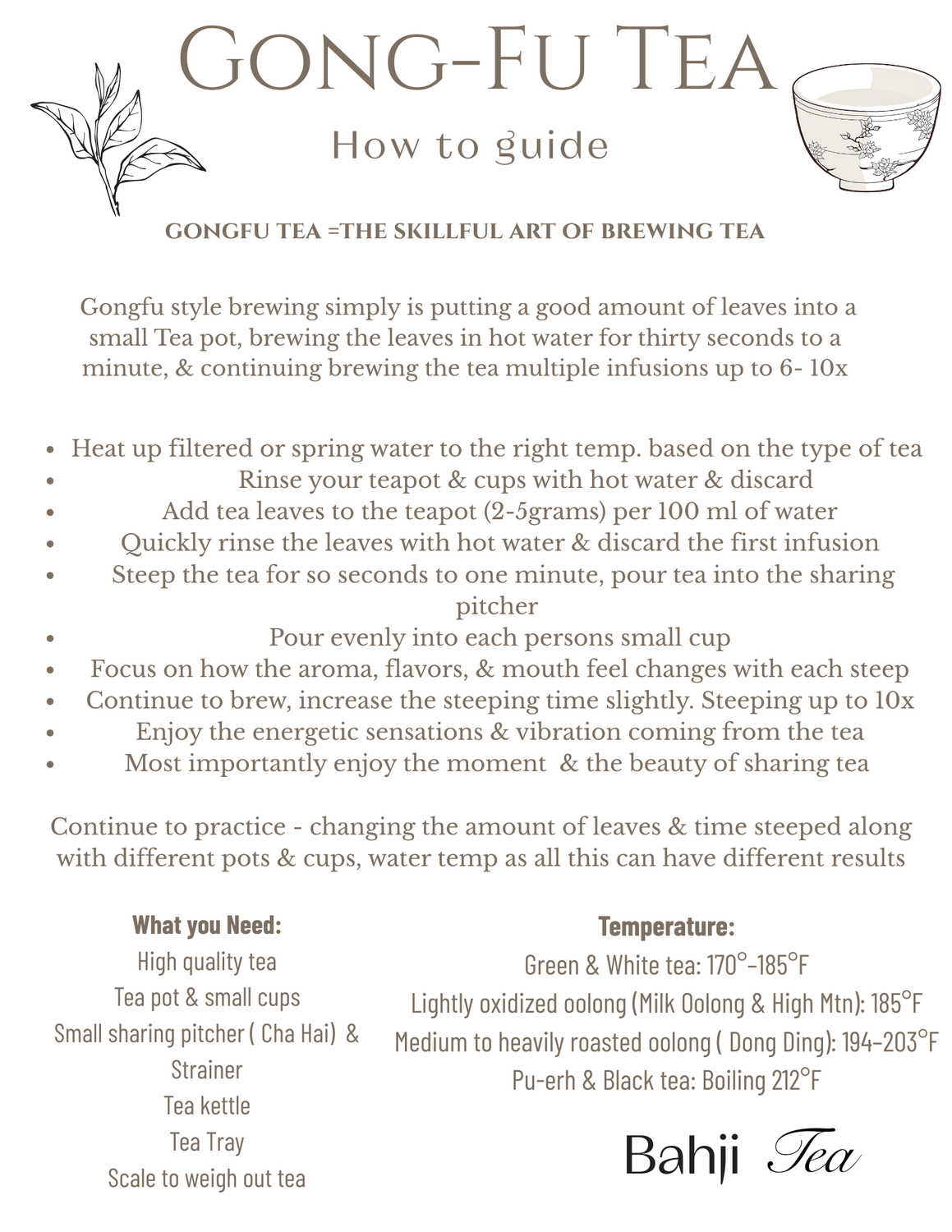Gong Fu Tea- How to guide (Free)
$0.00
Free Download
Step into the art of Gong Fu Cha with our free downloadable guide—a simple, beautiful introduction to this traditional tea brewing method.
In stock
Customer reviews
Reviews only from verified customers
No reviews yet. You can buy this product and be the first to leave a review.
Product Details
Free Gong Fu Brewing Guide
Step into the art of Gong Fu Cha with our free downloadable guide—a simple, beautiful introduction to this traditional tea brewing method.
What is Gongfu Tea?
Gongfu Cha is a way of brewing tea that invites you to slow down and engage with the leaves, water, and moment. It’s a method rooted in intention and presence—where a higher ratio of leaf to water, paired with small brewing vessels, draws out the deepest expression of the tea. While any tea can be prepared this way, the transformation is especially profound with oolongs and aged teas like puerh. What might taste simple in a mug opens into layers of aroma, texture, and energy when brewed gongfu-style.
The word gongfu (功夫) refers to skill developed over time—and brewing tea this way is just that: a practice. Precision, patience, and a feel for the leaves are all part of it. And while it takes a little more attention, what you receive in return is something far beyond a cup of tea—it’s a whole experience.
A Short History of Gongfu Brewing
Though often thought of as ancient, the practice of Gongfu Cha emerged in the Chaozhou region of southern China around the 18th century. It stayed mostly local until the 1970s, when a modern version began to take shape in Taiwan. There, it evolved into a fuller ritual with new tools, aesthetics, and a refined flow—eventually becoming what many today call the Chinese tea ceremony, or Zhonghua Chayi.
From Taiwan, this reimagined form of gongfu made its way back into mainland China, and in time, out into the world. What began as a humble regional tradition became a cultural symbol, now practiced by tea lovers across the globe. The original, minimalist Chaozhou-style still exists quietly alongside it—less adorned, but just as powerful in its simplicity.
How to Brew Gongfu Style
Gongfu brewing is an invitation to slow down and connect with tea in an intentional way. At its core, it means using a generous amount of leaf in a small teapot or gaiwan, brewing with hot water, and steeping the same leaves over and over—each infusion revealing something new. This method brings out the depth, aroma, and energy of the tea, especially with oolongs and aged puerh.
You don’t need fancy tools to start—just a small pot or gaiwan, cups, and a way to heat water. Use enough tea to mostly cover the bottom of your vessel (about 3–8g per 100ml of water). Rinse your leaves quickly with hot water to wake them up, then steep in short bursts—starting with 5–30 seconds and adjusting from there. You can brew the same leaves many times, depending on the tea and your preference.
Preheating your vessels, rinsing the leaves, and pouring precisely help refine the process, but you don’t have to get it perfect. Over time, you’ll develop your own feel for timing, temperature, and strength. Whether using a sturdy clay pot that softens and holds heat or a fast-pouring gaiwan that offers precision, the practice becomes second nature.
It’s less about rules and more about relationship—letting the tea guide you, one steep at a time.
Disclaimer:
This guide is for educational purposes only and is not intended to diagnose, treat, cure, or prevent any disease. The information provided is not a substitute for professional medical advice. Always consult your healthcare provider before beginning any new health routine, especially if you have a medical condition, are pregnant, or are taking medications.
Save this product for later
Powered by Lightspeed
Display prices in:USD
